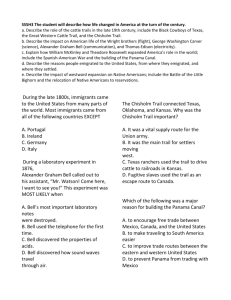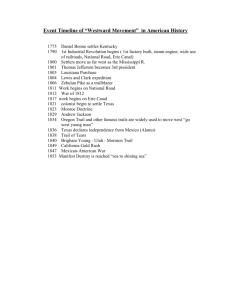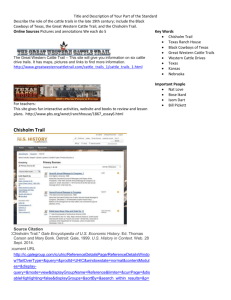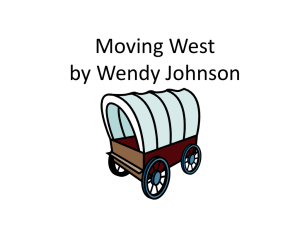Power Point - Henry County Schools
advertisement
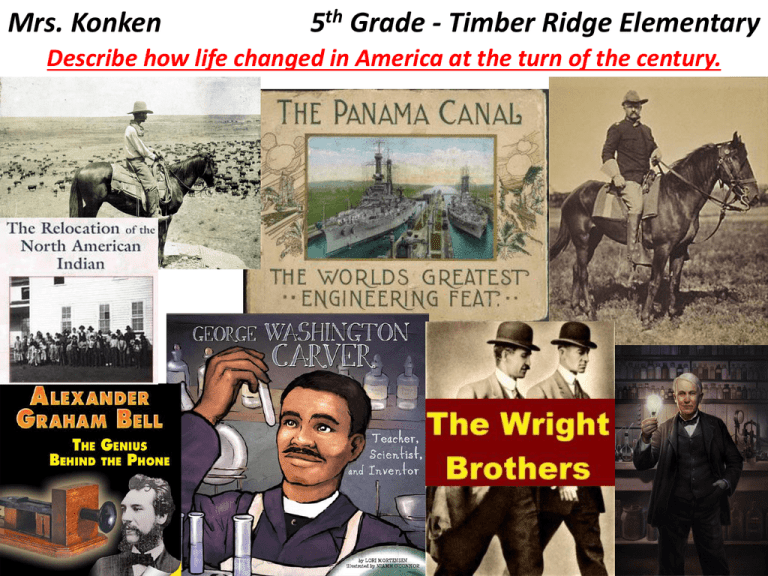
Mrs. Konken 5th Grade - Timber Ridge Elementary Describe how life changed in America at the turn of the century. Describe the role of the cattle trails in the late 19th century; include the Black Cowboys of Texas, the Great Western Cattle Trail, and the Chisholm Trail. Cattle drives were a major economic activity in the American west, particularly between 1866 and 1886, when 20 million cattle were herded from Texas to railheads in Kansas for shipments to stockyards in Chicago and points east. The long distances covered, the need for periodic rests by riders and animals, and the establishment of railheads led to the development of "cow towns" across the American West. The Chisholm Trail was a trail used in the late 19th century to drive cattle overland from ranches in Texas to Kansas railheads. The portion of the trail marked by Jesse Chisholm went from his southern trading post near the Red River, to his northern trading post near Kansas City, Kansas. Texas ranchers using the Chisholm Trail started on that route from either the Rio Grande or San Antonio, Texas, and went to the railhead of the Kansas Pacific Railway in Abilene, Kansas, where the cattle would be sold and shipped eastward. The Great Western Cattle Trail was used in the 19th century for movement of cattle to markets in the East. The trail was also known as the Western Trail, the Dodge City Trail, or the Old Texas Trail. The Great Western Trail began at Bandera west of San Antonio and passed near Buffalo Gap and Abilene, in West Texas. Continued on north of Dodge City, Kansas to Ogalalla NE and Belle Fousch SD. It ran west of and roughly parallel to the Chisholm Trail. Though less well known than the Chisholm Trail, the Great Western Cattle Trail was longer in length and carried cattle for two years longer than the Chisholm. The Great Western saw over seven million cattle and horses pass through Texas and Oklahoma to the railheads in Kansas and Nebraska, therefore, developing the cattle industry as far north as Wyoming and Montana. A typical head would move 10 -12 miles a day and included the trail boss, a wrangler, and a cook. The drive from South Texas to Kansas took about two months at a cost of $1000 in wages and provisions. At the end of the trail, cattle sold for $20.00 to $35.00 per head. Describe the impact on American life of the Wright brothers (flight) Wilbur and Orville Wright were American inventors and pioneers of aviation. “If birds can glide for long periods of time, then… why can’t I ?” Orville Wright http://wrightbrothers.info/index.php On December 17, 1903, Orville Wright piloted the first powered airplane 20 feet above a wind-swept beach in North Carolina. The flight lasted 12 seconds and covered 120 feet. Three more flights were made that day with Orville's brother Wilbur piloting the record flight lasting 59 seconds over a distance of 852 feet. The brothers began their experimentation in flight in 1896 at their bicycle shop in Dayton, Ohio. They selected the beach at Kitty Hawk as their proving ground because of the constant wind that added lift to their craft. In 1902 they came to the beach with their glider and made more than 700 successful flights. Having perfected glided flight, the next step was to move to powered flight. No automobile manufacturer could supply an engine both light enough and powerful enough for their needs. So they designed and built their own. All of their hard work, experimentation and innovation came together that December day as they took to the sky and forever changed the course of history. The brothers notified several newspapers prior to their historic flight, but only one - the local journal - made mention of the event. Describe the impact on American life of the George Washington Carver (science) George Washington Carver was born into slavery in Diamond, Missouri, around 1864. Carver went on to become one of the most prominent scientists and inventors of his time, as well as a teacher at the Tuskegee Institute. Carver is one of the most revered figures in early 20th century African-American history, and his work at the Tuskegee Institute in Alabama is considered instrumental in changing Southern approaches to agriculture Video 4:26 Who was George Washington Carver? Carver was born into slavery around 1864 and because he was black, many schools would not let him attend. But, Carver fought discrimination and prejudice and finally went to college. He studied agriculture, or farming, and figured out how to rotate crops to bring more nutrients into the soil. As an agricultural chemist, Carver discovered three hundred uses for peanuts and hundreds more uses for soybeans, pecans and sweet potatoes. Among the listed items that he suggested to southern farmers to help them economically were his recipes and improvements to/for: adhesives, axle grease, bleach, buttermilk, chili sauce, fuel briquettes, ink, instant coffee, linoleum , mayonnaise , meat tenderizer, metal polish, paper, plastic, pavement, shaving cream, shoe polish, synthetic rubber, talcum powder and wood stain. Describe the impact on American life of the Alexander Graham Bell (communication) Alexander Graham Bell was one of the primary inventors of the telephone and did important work in communication for the deaf and held more than 18 patents. •Bell’s mother and wife were both deaf, this had a major influence on his work. •Bell studied the human voice and worked with various schools for the deaf. Bell’s first words with the working telephone were spoken to his assistant Thomas Watson and were along the lines of “Mr Watson, come here. I want to see you.” Video 1:12 Bell improved on the design and by 1886 more than 150000 people owned telephones in the United States. Alexander Graham Bell (March 3, 1847 – August 2, 1922) was an eminent Scottishborn scientist, inventor, engineer and innovator who is credited with inventing the first practical telephone. Funny fact: Bell considered his most famous invention an intrusion on his real work as a scientist and refused to have a telephone in his study. Describe the impact on American life of the Thomas Edison (electricity). Inventor Thomas Edison created such great innovations as the electric light bulb and the phonograph. A savvy businessman, he held more than a 1,000 patents for his inventions. Born on February 11, 1847, in Milan, Ohio, Thomas Edison rose from humble beginnings to work as an inventor of major technology. Setting up a lab in Menlo Park, some of the products he developed included the telegraph, phonograph, electric light bulb, alkaline storage batteries and Kinetograph (a camera for motion pictures). By the time he died on October 18, 1931, Thomas Edison had amassed a record 1,093 patents: 389 for electric light and power, 195 for the phonograph, 150 for the telegraph, 141 for storage batteries and 34 for the telephone. Explain how William McKinley and Theodore Roosevelt expanded America’s role in the world; include the Spanish-American War and the building of the Panama Canal. America's Changing View of the World Up until the Spanish American War, the United States had only worried about their own problems. They fought against Mexico to establish their southern border. Then Americans spent 5 years fighting against each other in the American Civil War. The next 20 years were spent recovering from the damage the Civil War had caused. William McKinley and Teddy Roosevelt the American Presidents at the turn of the century began involving the United States in foreign issues. America came to the defense of Cuba and also claimed several foreign territories as their own. Then America paid 375 million dollars to build a canal through the country of Panama to improve the ease of transportation. Expansion of Alaska and Hawaii In acquiring Pacific possessions for the United States, McKinley expanded the nation’s ability to compete for trade in China. Statehood granted: August 21, 1959 Statehood granted: January 3, 1959 The United States’ first venture beyond its continental borders was the purchase of Alaska – sparsely populated by Inuit and other native peoples – from Russia in 1867. But 30 years later, when gold was discovered on Alaska’s Klondike River, thousands of Americans headed north, and many of them settled in Alaska permanently. During the war, McKinley also pursued the annexation of the Republic of Hawaii. The new republic, dominated by American interests, had seized power from the royal government in 1893. The Spanish-American War The Spanish American War was the first time the United States got involved in overseas issues. They came to the defense of Cuba who was rebelling against Spain. The United States was successful and claimed the Philippines, Guam and Puerto Rico as their own territories. Cuba gained its independence from Spain. The Panama Canal William McKinley began work on creating a shortcut through Central America to improve the ability to transport goods to the west coast. He was assassinated and Teddy Roosevelt made the final agreements with Panama, for the canal to be built. It wasn't finished, however, until 1914. The canal is still an important transportation route. As a matter of fact, in 2007 work began to expand the canal so larger modern ships could also use the shortcut. Describe the reasons people emigrated to the United States, from where they emigrated, and where they settled. “Give me your tired, your poor, your huddled masses yearning to breathe free.” Quote from Emma Lazarus' sonnet, New Colossus on the Statue of Liberty The reasons these new immigrants made the journey to America differed little from those of their predecessors. Escaping religious, racial, and political persecution, or seeking relief from a lack of economic opportunity or famine still pushed many immigrants out of their homelands. Many were pulled here by contract labor agreements offered by recruiting agents. Hungarians, Poles, Slovaks, Bohemians, and Italians flocked to the coal mines or steel mills, Greeks preferred the textile mills, Russian and Polish Jews worked the needle trades or pushcart markets of New York. Railroad companies advertised the availability of free or cheap farmland overseas in pamphlets distributed in many languages, bringing a handful of agricultural workers to western farmlands. But the vast majority of immigrants crowded into the growing cities, searching for their chance to make a better life for themselves. Immigrants entering the United States who could not afford first or second-class passage came through the processing center at Ellis Island, New York. Built in 1892, the center handled some 12 million European immigrants, herding thousands of them a day through the barn-like structure during the peak years for screening. Government inspectors asked a list of twenty-nine probing questions, such as: Have you money, relatives or a job in the United States? Are you a polygamist? An anarchist? Next, the doctors and nurses poked and prodded them, looking for signs of disease or debilitating handicaps. Usually immigrants were only detained 3 or 4 hours, and then free to leave. If they did not receive stamps of approval, and many did not because they were deemed criminals, strikebreakers, anarchists or carriers of disease, they were sent back to their place of origin at the expense New York City of the shipping line. Ellis Island Liberty Island Describe the impact of westward expansion on Native Americans As Far Western Expansion picked up, it became clear that just as before, the goals of American expansionists conflicted with the needs of the Indians in the area of expansion. Many of the Plains tribes depended on the buffalo for survival. Several tribes followed the buffalo migration, harvesting conservatively to fill tribal needs. By the 1870s, however, the buffalo population was on the decline. Non-Indians killed the buffalo for their pelts, to feed railroad construction crews, or even just for the pure sport of it. Army commanders who operated in the West often attempted to drive the Indians off of desired lands by killing the buffalo as a way to deprive the Indians of supplies. Battle of the Little Bighorn When gold was discovered in the Black Hills of South Dakota, the federal government announced that Custer's forces would hunt down all Sioux not in reservations after January 31, 1876. Many Sioux refused to comply, and Custer began to mobilize his troops. "CUSTER'S LAST STAND" The great Lakota Indian warrior, Chief Sitting Bull, is perhaps best known in early American history as the chief who defeated General Custer in 1876 at the Battle of Little Bighorn. The Sioux, Cheyenne, Arapaho and other tribes set aside their differences in the face of intolerable abuse by the U.S. Government, and their warriors were amassing in the thousands when General George Custer ordered his 700 soldiers of the 7th Cavalry of the United States Army to attack the Indian war party and his 700-troop regiment was subsequently annihilated in the ensuing battle. Relocation of Native Americans to reservations As early as the 1860s, the US government had abandoned its policy of treating much of the West as a large Indian reserve, and introduced a system of small, separate tribal reservations, where the Indians were to be concentrated. Before After The original natives of the area that is now Georgia Chief Sitting Bull (Sioux) Chief Geronimo (Apache) Chief John Ross (Cherokee) Standing Bear (Ponca) Chief Little Raven (Arapaho) Maybe you have heard about a few great American Indian chiefs? Chief Crazy Horse (Lakota) Chief Ten Bears (Comanche) Cochise (Apache) Mrs. Konken’s hometown fact The Chief Standing Bear Memorial Bridge is a bridge across the Missouri River at the Nebraska-South Dakota border. Located near Niobrara, Nebraska. The bridge is named for Standing Bear, a Ponca chief born and buried nearby, who was the plaintiff in Standing Bear v. Crook, a landmark 1879 U.S. District Court case that established the legal rights of Native Americans to move about freely. Chief Standing Bear (Ponca) Pow Wows are a way for our local American Indians to preserve their heritage
